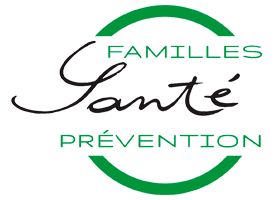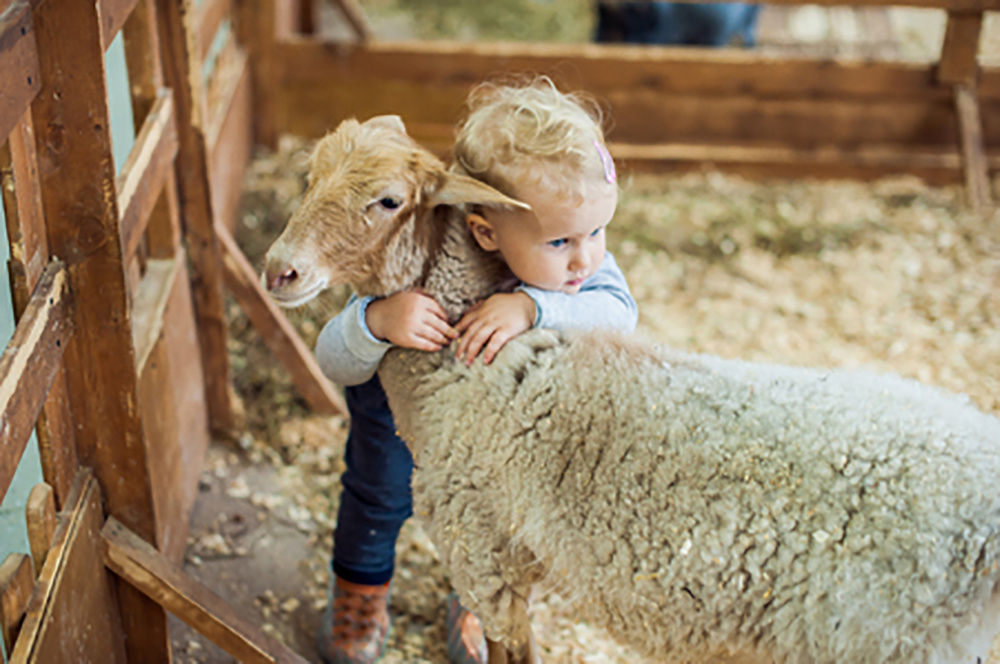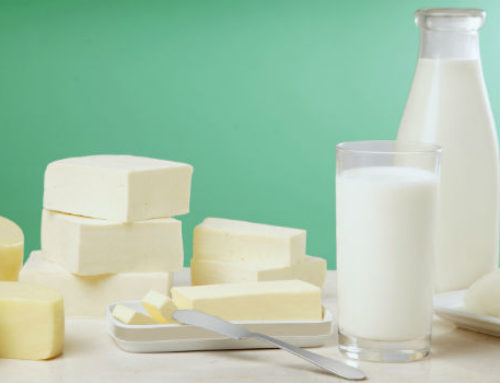Letter of Christine Bouguet-Joyeux – 28th of December 2017
2/ Animal milks: from cows, goats, sheep, mares, donkeys, buffalos, camels …
Obviously, cow’s milk is the most popular milk in our countries. However, other mammal’s milks are used in other countries: from cows, goats, sheep, mares, donkeys, buffalos, and in Eastern countries, perhaps also camels.
Let’s not forget that these milks are naturally made for the needs of animals’ babies: the cow’s calf, the sheep’s lamb, the goat’s kid, the horse’s foal, the donkey’s baby, and the young camel.
If they are used for humans, they must first be conditioned, sterilized, and stored so they can be put at families’ (children and increasingly, adults) disposal in the best possible conditions. They must not contain growth factors, naturally found in these milks and that are meant for the growth of animal’s bodies. Despite this, industrial conservation is ensured through UHT (ultra-high temperature) process. At temperature, 130°C to 140°C or 266°F to 284°F, growth factors are not destroyed. Consequently, humans do consume them without knowing.
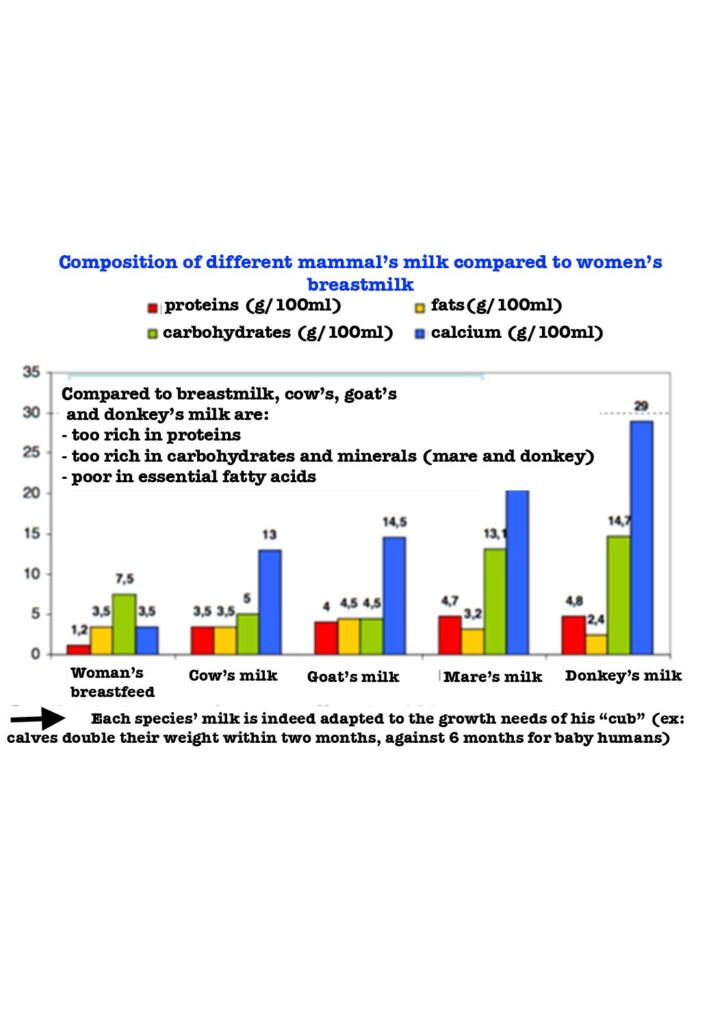
Animal milk and women’s breast milk comparative table.
(ISPED, Université Bordeaux 2, France)
Cow’s milk and other animals’ milks
Cow’s milk is the most popular milk, because it is also produced in much greater quantities, cheaper, and largely distributed and promoted in advertisements funded by industrial lobbies.[1]
Let us not dig into the consequences of a high-yield-oriented agriculture. Sanitary, collection, storage, distribution and conditioning imperatives also greatly impact the quality of final products. Notice that cow’s milk stems from a very big mammal. It is destined to the calf, which takes over 350kg (770lbs) in its first year of life, and whose needs are completely opposed to baby human’s needs. The growth factors it contains (EpidermalGrowth Factor, TransformingGrowth Factor, InsulinGrowth Factor) greatly impact the size, weight, metabolism of the animal.
Cows’ milk components are very different than what are useful to baby humans, who have neither the same nutritional needs nor the same growth patterns, and whose weight and bone evolution differ completely.
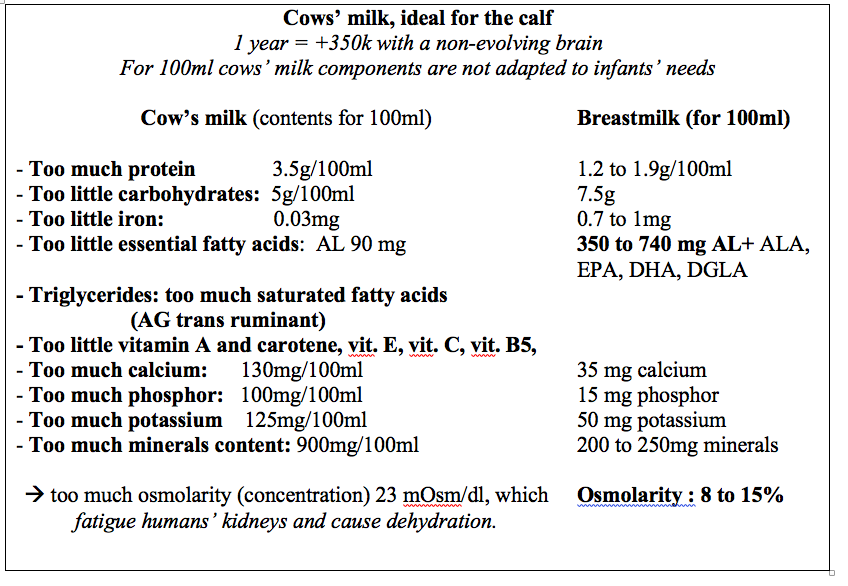
From a nutritional composition standpoint, it is better to have goat or sheep’s milk (raised freely in nature). Their fatty acids, minerals and calcium contents are more balanced, especially because growth factors they contain are meant for smaller animals. Ideally, these milks should be pasteurized. They are hard to find on the market. In France, they can be found in powder form, in organic health shops. Sheep milk is very dense in nutrients and less rich in water: it must be diluted. In case of allergic family history, be prudent, because all these animal milks’ proteins are “cousins”.
The industry also proposes mares’ milk. It is reputed since antiquity for its revitalizing qualities. It is also used as replacement to mothers’ milk in Asia, and in a few European countries. Its composition is all the more advantageous (vitamin C, zinc, essential and poly-unsaturated fatty acids, that are not synthesized by our body…) when pastures carefully chosen: milks tend to have better quality when the animal lives in the mountains because of the fatty grass they eat, more abundant in altitude. However, it is richer in animal lactose, and again stems from a big animal.
Comparing Animal Milks
(Source : Guide Pratique de gastronomie Familiale, C. Bouguet-Joyeux, See below, note 1)

Advantages
These are mammals’ milks, that contain many nutrients necessary to their newborn, little animals that aren’t yet nutritionally autonomous.
Drawbacks
However, it does not mean that they are adapted to babies from other mammals’ species. Each animal’s needs are different. Some of their components are often allergenic to humans, such as protein (responsible for CMPA, i.e. cows’ milk protein allergies), or lactose. Additionally, their fatty acids are different. These milks contain too much saturated fatty acids, (goat’s and sheep’s milks contain proteins that are smaller than cow’s milks, and more easily digestible), omega 6, are too low in omega 3 fatty acids. Moreover, proportions also are different: for example, cow’s milk contains 4 times more calcium and 3 times more proteins than breastmilk.
What are lactose intolerance symptoms? Cramps, gas, diarrhea (increasing in age) because of our body’s lack of lactose digestion enzyme, lactase.
– Allergenic proteins:
Milk contain more than 30 proteins, all have allergenic potential, especially casein and β-lactoglobulin. This is why there is not just one type of CMPA, cow’s milk protein allergy. Casein triggers durable, even permanent allergies. Different types of casein are not destroyed by heat, and therefore not by industrial milk processing. Some of them resist stomach acidity, or fermentation. These big molecules are difficult to digest, and trigger digestive issues and cross-allergies.
Cow’s Milk Protein Allergy (CMPA)
This type of allergy appears shortly after switching from breastmilk to cow’s milk. Cow’s milk is the most common first food introduced into infant’s diets. Sometimes, an allergy can also be felt through breastfeeding, if the breastfeeding mother consumes milks and other cow’s milks-containing foods. Mother’s milk quality typically depends upon quantities of milk she ingests.
Currently, all adverse reactions to cows’ milks are referred to as IgE or non-IgE-dependent Cow’s milk protein allergy (where IgE stands for immunoglobulin). This means that levels of E immunoglobulins, which are signs of allergy, may or may not increase. Non-IgE dependent reactions are not immune-related and they are the most frequent.
Symptoms include:
Digestive symptoms (50 to 60%), skin symptoms (eczema 10 to 30%) Anaphylactic shock (9% CMPAs) can occur immediately when the child is affected, or during reintroduction attempts. [2]_.
Anaphylactic choc (affects 9% of CMPAs) can occur when the child consumes dairy, or more frequently, during reintroduction attempts.
Strong immunological manifestations of CMPAs (associated with elevations of IgE in the blood) include rashes, angioedema (swelling of the internal layer of the skin). They can affect some of the infant’s body parts: face, lips, tongue, even palate, larynx and vocal cords (in serious cases).
Rhinitis symptoms (associated or not with conjunctivitis) and bronchospasms also are symptoms linked to IgE dependent cow’s milk allergies. Eczema and digestive symptoms are common symptoms of non-immunological CPMAs. For example, one can observe severe eczema in infants despite the use of dermo-corticoids treatments. Digestive signs include nausea, abdominal pains, vomiting, diarrhea, and blood in the stools. Other associated issues include irritability, sleep issues, weak growth in height and weight and chronic constipation.
Infants’ Allergies
CMPAs affect at least 8% of children under 1. Note that heating the milk does not improve its tolerance.
How to check for a CMPA? There is a patch-test which is more informative than the oral food challenge test. When reintroducing cow’s milk after age two, which is not recommended, the tolerance can improve. However, oftentimes it is only partial, as opposed to total as was previously believed. Indeed, in older children, rates of digestive diseases in children that had no CMPAs are increasing. In children, one observes ear infections, rhinitis, asthma, rashes and dermal irritation, and chronic stomach bugs. ENT physicians and pediatricians are increasingly aware of this and recommend that cows’ dairy product be avoided.
Goat and sheep’s milk allergies also exist. They often arise at the same time as CPMAs (these are called «cross-allergies »), or are linked to other allergies (polyallergies). This allergy occurs even after ingestion of small quantifies, sometimes non-identified, or when using containers that were in contact with these foods. Then, symptoms are more severe. Therefore, avoid these milks with a child who’s allergic to them or whose parents are allergic[3]_.
Parents’ Allergies
Babies with intolerant or allergic parents are at more risk to becoming allergic themselves. Therefore, avoid all cow dairy products, and try breastfeeding them for a long time so as to develop their immune system and their gut ecosystem.
It is also not recommended to use milk and cow’s milks derived products with infants under 4 months of age, who have a family history of diabetes mellitus. They act as environmental factor predisposing them to type 1 diabetes because of cow’s milk contents in insulin-like grows factors IGF [4].
Therefore, it is essential to encourage breastfeeding everywhere in the world. It is more natural, eco-friendly, and more adapted to infants’ first year of life.
Not only is it essential to infants’ health, but also it one – although not the only one – protective factor for his mother’s mammal glands. Pretending that breastfeeding damages the breast and deteriorates mammal esthetics is a marketing argument meant to promote artificial milks. We will demonstrate that these milks are far from useful to our children’s health or his mother’s. They are mostly meant to increase the industry’s return profits.
Best regards,
Christine Bouguet-Joyeux – Nutritionnist
Sources
[1] 780 liters or qt cow’s milk are produced every second in France. They total approximately 24.6 millions tons per year as of 2014. Within Europe, the French cow’s milk industry is in second place after Germany’s. The French spend 14% of their food budget on dairy, which is excessive and explains a high number of diseases and weakening of immune defenses.
[2]http://www.allergienet.com/traitement-reaction-anaphylactique-allergie-alimentaire/
[3]http://www.allergienet.com/allergie-lait-chevre-brebis/
[4]M. Knip, HK. Akerblom, “Environmental factors in the pathogenesis of type I diabetesmellitus”, Exp. Clin. EndocrinolDiabetes.
The Letter of Professeur Joyeux is an independent and free information service est un service. It specializes providing the wider public and families with disease prevention information.
This health advice is provided free of charge by this organization and cannot be considered as personal medical advice. No treatment should be initiated solely on the basis of this content. It is strongly advised to consult a properly licensed health professional to seek responses with regard to one’s health and well-being. No information or product mentioned on this website is meant to diagnose, treat, atone or cure a disease.
You have a Personal Health Question? (Confidential response) or you wish to enjoy our exclusive services? Become an exclusive member of our association for one year by clicking HERE
